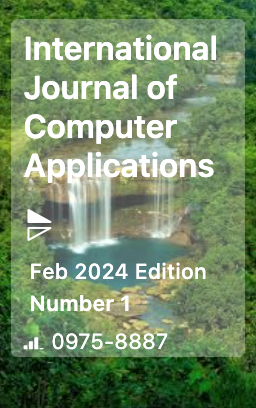Reseach Article
Iris Recognition System using LBP and Linear SVC
| Journal of Advanced Artificial Intelligence |
| Foundation of Computer Science (FCS), NY, USA |
| Volume 1 - Number 6 |
| Year of Publication: 2025 |
| Authors: Mahesha Y. |
 10.5120/jaai202426
10.5120/jaai202426
|
Mahesha Y. . Iris Recognition System using LBP and Linear SVC. Journal of Advanced Artificial Intelligence. 1, 6 ( Mar 2025), 1-10. DOI=10.5120/jaai202426
Abstract
In this paper, experiment has been conducted to find the optimum iris recognition system between the combinations Local Binary Pattern (LBP) and Distance metric, and LBP and Linear Support Vector Classifier (SVC). First, experiment has been conducted using LBP and different distance metrics. For each of the distance metric, the FAR, FRR and accuracy have been calculated for different threshold values. From the obtained result, it has been found that cityblock distance gives better accuracy compared to remaining distance metrics and the accuracy obtained is 65.93% on CASIA iris dataset. Secondly, iris recognition has been carried out using Local Binary Pattern (LBP) and Linear Support Vector Classifier (SVC). The combination of LBP and Linear SVC is giving an accuracy of 91.83% on CASIA iris dataset.
References
- A fast iris recognition system through optimum feature extractionRana HK, Azam MS, Akhtar MR, Quinn JMW, Moni MA. 2019. A fast irisrecognition system through optimum feature extraction. PeerJ ComputerScience 5:e184 https://doi.org/10.7717/peerj-cs.184
- Naseem, I., Aleem, A., Togneri, R., and Bennamoun, M. (2017). Iris recognition using class-specificdictionaries. Computers & Electrical Engineering, 62:178–193.
- Umer, S., Dhara, B. C., and Chanda, B. (2017). A novel cancelable iris recognition system based on feature learning techniques. Information Sciences, 406:102–118.
- Galdi, C., Nappi, M., and Dugelay, J.-L. (2016). Multimodal authentication on smartphones: Com- bining iris and sensor recognition for a double check of user identity. Pattern Recognition Letters,222 82:144–153.
- Nabti, M. and Bouridane, A. (2008). An effective and fast iris recognition system based on acombined multiscale feature extraction technique. Pattern recognition, 41(3):868–879.
- G J Yang and T S Huang. (1981). The effect of median filtering on edge location estimation. Computer graphics and Image processing, 15(3): 224-245.
- Chiluka Nagaraju and I Raja sekhar Reddy (2016). Canny scale edge detection. International Journal of Engineering Trends and Technology (IJETT).
- Li Liu, Lingjun Zhao, Yunli Long, Gangyao Kuang and Paul Fieguth. 2012. Extended local binary patterns for texture classification. Image and Vision Computing, 30(2):86-99.
- Loris Nanni, Alessandra Lumini and Sheryl Brahnam. 2010. Local binary patterns variants as texture descriptors for medical image analysis. Artificial Intelligence in Medicine, 49(2): 117-125.
- SONG Ke-Chen1 YAN Yun-Hui1 CHEN Wen-Hui1 ZHANG Xu1, Research and Perspective on Local Binary Pattern. Acta Automatica Sinica, 39(6): 731-745.
- Timo Ahonen, Abdenour Hadid and Matti Pietikainen, Face recognition with Local Binary Pattern. European Conference on Computer Vision, 469-481.
- Di Huang, Caifeng Shan, Mohsen Ardebilian, Yunhong Wang and Liming Chen. Local Binary Patterns and Its Application to Facial Image Analysis: A Survey, IEEE Transactions on Systems, Man, and Cybernetics, Part C (Applications and Reviews), 41(6), 765-781.
- Lubor Ladicky and Philip H S Torr. 2011. Locally Linear Support Vector Machines, International Conference on Machine Learning, Bellevue, WA, USA.
- Chunhua Zhanga , Xiaojian Shaob and Dewei Lia. 2015. Knowledge-based Support Vector Classification Based on C-SVC. Information Technology and Quantitative Management. 1083-1090.
- Chia-Hua Ho and Chih-Jen Lin. 2012. Large-scale Linear Support Vector Regression. Journal of Machine Learning Research. 3323-3348.
- Leo Liberti, Carlile Lavor, Nelson Maculan and Antonio Mucherino. 2012. Quantitative methods. arXiv:1205.0349.
- Dokmanic, R. Parhizkar, J. Ranieri and M. Vetterli, "Euclidean Distance Matrices: Essential theory, algorithms, and applications," in IEEE Signal Processing Magazine, vol. 32, no. 6, pp. 12-30, Nov. 2015, doi: 10.1109/MSP.2015.2398954.
- Y. Pan, J. L. Trahan and R. Vaidyanathan, "A Scalable and Efficient Algorithm for Computing the City Block Distance Transform on Reconfigurable Meshes," in The Computer Journal, vol. 40, no. 7, pp. 435-440, Jan. 1997, doi: 10.1093/comjnl/40.7.435.
- Mitra, Debasree & Sarkar, Parantapa & Roy, Payel. (2019). Face Recognition by City-Block Distance Classifier in Supervised Machine Learning. 10.1729/Journal.21653.
- Merigo, Jose M. & Casanovas, Montserrat. (2012). A New Minkowski Distance Based on Induced Aggregation Operators. International Journal of Computational Intelligence Systems. April 2011. 123-133. 10.1080/18756891.2011.9727769.
- Groenen, Patrick & Kaymak, Uzay & Rosmalen, J.M.. (2006). Fuzzy clustering with Minkowski distance. Erasmus University Rotterdam, Econometric Institute, Econometric Institute Report.
- Rahutomo, Faisal & Kitasuka, Teruaki & Aritsugi, Masayoshi. (2012). Semantic Cosine Similarity.
- Sitikhu, Pinky & Pahi, Kritish & Thapa, Pujan & Shakya, Subarna. (2019). A Comparison of Semantic Similarity Methods for Maximum Human Interpretability.
- Somerfield, Paul. (2008). Identification of the Bray-Curtis similarity index: Comment on Yoshioka (2008). Marine Ecology-progress Series - MAR ECOL-PROGR SER. 372. 303-306. 10.3354/meps07841.
- Edward W. 1984. Beals,Bray-Curtis Ordination: An Effective Strategy for Analysis of Multivariate Ecological Data, Editor(s): A. MacFadyen, E.D. Ford, Advances in Ecological Research, Academic Press, 14: 1-55.
- Coghetto, Roland. (2016). Chebyshev Distance. Formalized Mathematics. 24. 10.1515/forma-2016-0010.
- Kløve, Torleiv & Lin, Te-Tsung & Tsai, Shi-Chun & Tzeng, Wen-Guey. (2009). Permutation Arrays Under the Chebyshev Distance. IEEE Transactions on Information Theory. 56. 10.1109/TIT.2010.2046212.
- Hassan, Sabit & Shaar, Shaden & Raj, Bhiksha & Razak, Saquib. (2018). Online Evaluation of Classifier Accuracy, False Acceptance Rate and False Rejection Rate.
Index Terms
Keywords

